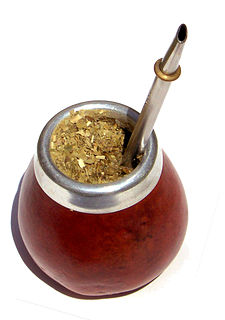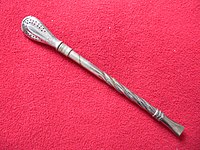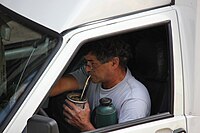Pronounced Ma Tay (first vowel short and second long so it is like the Ma in Mama and the second vowel is like the word say.
Mate (beverage)
From Wikipedia, the free encyclopedia
| This article needs additional citations for verification. (November 2010) |

Mate in a traditional calabash gourd
|
|
| Type | Infusion |
|---|---|
| Country of origin | Paraguay, Uruguay, Argentina, Bolivian Chaco, southern Brazil |
| Introduced | 16th century AD[1] |
It is prepared by steeping dried leaves of yerba mate (Ilex paraguariensis, known in Portuguese as erva-mate) in hot water and is served with a metal straw from a shared hollow calabash gourd. The straw is called a bombilla in Spanish, a bomba in Portuguese, and a bombija or, more generally, a masassa (type of straw) in Arabic. The straw is traditionally made of silver. Modern, commercially available straws are typically made of nickel silver, called alpaca; stainless steel, or hollow-stemmed cane. The gourd is known as a mate or a guampa; while in Brazil, it has the specific name of cuia, or also cabaça (the name for Indigenous-influenced calabash gourds in other regions of Brazil, still used for general food and drink in remote regions). Even if the water is supplied from a modern thermos, the infusion is traditionally drunk from mates or cuias.
Yerba mate leaves are dried, chopped, and ground into a powdery mixture called yerba. The bombilla acts as both a straw and a sieve. The submerged end is flared, with small holes or slots that allow the brewed liquid in, but block the chunky matter that makes up much of the mixture. A modern bombilla design uses a straight tube with holes, or a spring sleeve to act as a sieve.[6]
"Tea-bag" type infusions of mate (Spanish: mate cocido, Portuguese: chá mate) have been on the market in Argentina, Paraguay and Uruguay for many years under such trade names as "Taragüi" in Argentina, "Pajarito" and "Kurupí" in Paraguay, and Matte Leão in Brazil.
Contents
Name
A typical bomba/bombilla or straw
In Brazil, traditionally prepared mate is known as chimarrão, although the word mate and the expression "mate amargo" (bitter mate) are also used in Argentina and Uruguay. The Spanish cimarrón means "rough", "brute", or "barbarian", but is most widely understood to mean "feral", and is used in almost all of Latin America for domesticated animals that have become wild. The word was then used by the people who colonized the region of the Río de la Plata to describe the natives' rough and sour drink, drunk with no other ingredient to soften the taste.
Preparation
The preparation of mate is a very simple process which consists of filling the gourd with yerba, pouring hot but not boiling water over the leaves, and drinking with a straw, the bombilla, which acts as a filter so as to draw only the liquid and not the yerba leaves. The method of preparing the mate infusion varies considerably from region to region, and which method yields the finest outcome is debated. However, nearly all methods have some common elements. The beverage is traditionally prepared in a gourd recipient, also called mate or guampa in Spanish and cuia in Portuguese, from which it is drunk. The gourd is nearly filled with yerba, and hot water[11] (typically at 70 to 85 °C (158 to 185 °F), never boiling[12]) is added.The most common preparation involves a careful arrangement of the yerba within the gourd before adding hot water. In this method, the gourd is first filled one-half to three-quarters of the way with yerba. Too much yerba will result in a "short" mate; conversely, too little yerba results in a "long" mate, both being considered undesirable. After that, any additional herbs (yuyo, in Portuguese jujo) may be added for either health or flavor benefits, a practice most common in Paraguay, where people acquire herbs from a local yuyera (herbalist) and use the mate as a base for their herbal infusions. When the gourd is adequately filled, the preparer typically grasps it with the full hand, covering and roughly sealing the opening with the palm. Then the mate is turned upside-down, and shaken vigorously, but briefly and with gradually decreasing force, in this inverted position. This causes the finest, most powdery particles of the yerba to settle toward the preparer's palm and the top of the mate.
Once the yerba mate has settled, the mate is carefully brought to a near-sideways angle, with the opening tilted just slightly upward of the base. The mate is then shaken very gently with a side-to-side motion. This further settles the yerba mate inside the gourd so that the finest particles move toward the opening and the yerba is layered along one side. The largest stems and other bits create a partition between the empty space on one side of the gourd and the lopsided pile of yerba on the other.
After arranging the yerba along one side of the gourd, the mate is carefully tilted back onto its base, minimizing further disturbances of the yerba as it is re-oriented to allow consumption. Some slumping (settling) is normal, but is not desirable. The angled mound of yerba should remain, with its powdery peak still flat and mostly level with the top of the gourd. A layer of stems along its slope will slide downward and accumulate in the space opposite the yerba (though at least a portion should remain in place).
Homemade bamboo bombillas
Typical silver mate straw
Now the mate is ready to receive the straw. Many people choose to pour warm water into the mate before adding the straw, while others insist that the straw is best inserted into dry yerba.[citation needed] Wetting the yerba by gently pouring cool water into the empty space within the gourd until the water nearly reaches the top, and then allowing it to be absorbed into the yerba before adding the straw, allows the preparer to carefully shape and "pack" the yerba's slope with the straw's filtering end, which makes the overall form of the yerba within the gourd more resilient and solid. Dry yerba, though, allows a cleaner and easier insertion of the straw, but care must be taken so as not to overly disturb the arrangement of the yerba. Such a decision is entirely a personal or cultural preference. The straw is inserted with one's thumb on the upper end of the gourd, at an angle roughly perpendicular to the slope of the yerba, so that its filtering end travels into the deepest part of the yerba and comes to rest near or against the opposite wall of the gourd. It is important for the thumb to form a seal over the end of the straw when it is being inserted, or the negative pressure produced will draw in undesirable particulates.
Brewing
Statue of a man preparing mate, in Posadas, Misiones, Argentina
Once the hot water has been added, the mate is ready for drinking, and it may be refilled many times before becoming lavado (washed out) and losing its flavor. When this occurs, the mound of yerba can be pushed from one side of the gourd to the other, allowing water to be added along its opposite side; this revives the mate for additional refillings and is called "reformar o/el mate" (reforming the mate).
Etiquette
Mate drinking in public is normal in Uruguay (Colonia del Sacramento)
Man drinking mate in his car (Buenos Aires).
Some drinkers like to add sugar or honey, creating mate dulce or mate doce (sweet mate), instead of sugarless mate amargo (bitter mate), a practice said to be more common in Brazil outside its southernmost state. Traditionally, natural gourds are used, though wood vessels, bamboo tubes, and gourd-shaped mates, made of ceramic or metal (stainless steel or even silver) are also common. The gourd is traditionally made out of the porongo or cabaça fruit shell. Gourds are commonly decorated with silver, sporting decorative or heraldic designs with floral motifs.
History
Main article: History of yerba mate
Lithograph of José Gaspar Rodríguez de Francia, a 19th-century ruler of Paraguay, with a mate and its respective bombilla
Brazil then became the largest producer of mate. In Brazilian and Argentine projects in late 19th and early 20th centuries, the plant was domesticated once again, opening the way for plantation systems. When Brazilian entrepreneurs turned their attention to coffee in the 1930s, Argentina, which had long been the prime consumer, took over as the largest producer, resurrecting the economy of Misiones Province, where the Jesuits had once had most of their plantations. For years, the status of largest producer shifted between Brazil and Argentina.[15]
Today, Brazil is the largest producer with 53%, followed by Argentina, 37%, and Paraguay, 10%.[16]
Culture
Mate has a strong cultural significance both in terms of national identity and well as socially, to the extent of being the national drink of Argentina,[17] Paraguay, where it is also consumed with either hot or ice cold water (see tereré).[18] Drinking mate is a common social practice in parts of Brazil, Chile, Argentina, Paraguay, Uruguay and eastern Bolivia. Throughout the Southern Cone, it is considered to be a tradition taken from the gauchos or vaqueros, terms commonly used to describe the old residents of the South American pampas, chacos, or Patagonian grasslands, found principally in parts of Argentina, Paraguay, Uruguay, southeastern Bolivia, southern Chile and southern Brazil.Parque Histórico do Mate, funded by the state of Paraná (Brazil), is a park aimed to educate people on the sustainable harvesting methods needed to maintain the integrity and vitality of the oldest wild forests of mate in the world.[19][20]
Mate is also consumed as an ice tea in various regions of Brazil, originating both from an industrialized form, produced by Matte Leão, and from artisanal producers. It is part of the beach culture in Rio de Janeiro, where it is widely sold by beach vendors,[21] being the hot infused variation uncommon in the area.
A matero, feminine matera, is a person who often enjoys drinking mate.[citation needed]
Health effects
See also: Yerba mate § Health effects
Like coffee and tea, mate is generally recognized as safe by the United States Food and Drug Administration. Drinking hot mate, however, is "probably carcinogenic to humans" according to the IARC Group 2A carcinogens list. A number of studies suggest mate may increase cancer risk, and reduce certain cardiovascular risks.Mate contains several vitamins and minerals important to human health, including vitamins A (as beta-carotene), B1, B2, C, and E, as well as phosphorus, iron and calcium.[11][22]
Correlations with incidence of cancer
A review of a number of population studies in 2009 revealed evidence of an association between esophageal cancer and hot mate drinking, but these population studies may not be conclusive.[23] Some research has suggested the correlation with esophageal cancer results almost entirely from hot mate's temperature; similar links to cancer have been found for tea and other beverages generally consumed at high temperatures. While drinking mate at very hot temperatures is considered as "probably carcinogenic to humans" on the IARC Group 2A carcinogens list, mate itself is not classifiable as to its carcinogenicity to humans.[24]Researchers from NCI (National Cancer Institutes) and Brazil found both cold- and hot-water extractions of popular commercial yerba mate products contained high levels (8.03 to 53.3 ng/g dry leaves) of carcinogenic polycyclic aromatic hydrocarbons (PAHs) (i.e. benzo[a]pyrene).[25] However, these potential carcinogenic compounds originated from the commercial drying process of the mate leaves, which involves smoke from the burning of wood, much like polycyclic aromatic hydrocarbons found in wood-smoked meat.[26] "Unsmoked" or steamed varieties of yerba mate tea are available,[27] which may reduce this risk, though research comparing relative cancer risks of smoked versus steamed yerba mate is not available. One study found the antioxidant properties of mate remain the same between both smoked and unsmoked varieties.[28]
Other properties
Antioxidant
Anticancer activity is plausible, if unproven, in part because yerba mate tea contains significant levels of polyphenol antioxidants, and has a slightly higher antioxidant capacity than green tea. On average, mate tea contains 92 mg of the antioxidant chlorogenic acid per gram of dry leaves, and no catechins,[22] giving it a significantly different antioxidant profile to other teas.[29]Antimicrobial and anti-fungal properties
The aqueous solution of yerba mate has been shown to have antimicrobial activities against E. coli bacteria. 40 mg of mate extract created a 4.5-log reduction in E. coli in apple juice and tryptic soy broth purposefully inoculated with the bacteria.[30] Mate tea extract was demonstrated to have inhibitory activity against a common skin fungus, M. furfur, known to be a cause of dandruff.Legendary origins
See also: Guaraní creation myth
The Guaraní people started drinking mate in a region that currently
includes Paraguay, southern Brazil, southeastern Bolivia, northeastern
Argentina and Uruguay. The Guaraní have a legend that says the Goddesses
of the Moon and the Cloud came to the Earth one day to visit it, but
they instead found a yaguareté (jaguar)
that was going to attack them. An old man saved them, and, in
compensation, the goddesses gave the old man a new kind of plant, from
which he could prepare a "drink of friendship".Variants
Carbonated mate soft drinks from Germany
In Uruguay and Brazil, the traditional gourd is usually big with a corresponding large hole. In Argentina (especially in the capital Buenos Aires), the gourd is small and has a small hole and people sometimes add sugar for flavor.
In Uruguay, people commonly walk around the streets toting a mate and a thermos with hot water. In some parts of Argentina, gas stations sponsored by yerba mate producers provide free hot water to travelers, specifically for the purpose of drinking during the journey. Disposable mate sets with a plastic mate and straw and sets with a thermos flask and stacking containers for the yerba and sugar inside a fitted case are available.
Iced mate cocido
Travel narratives, such as Maria Graham's Journal of a Residence in Chile, show a long history of mate drinking in central Chile. Many rural Chileans drink mate, in particular in the southern regions, particularly Chiloé and Magallanes.
Mate is consumed as an ice tea in various regions of Brazil, in both
artisanal and industrial forms. This is a bottle of industrialized mate
ice tea, bought from a local supermarket in Rio de Janeiro.
According to a major retailer of mate in San Luis Obispo, California, by 2004, mate had grown to about 5% of the overall natural tea market in North America.[32][33] Loose mate is commercially available in much of North America. Bottled mate is increasingly available in the United States. Canadian bottlers have introduced a cane sugar-sweetened, carbonated variety, similar to soda pop. One brand, Sol Mate, produces 10-ounce glass bottles available at Canadian and U.S. retailers, making use of the pun for the sake of marketing.[34]
See also
- Black drink
- Huarisnaque (Chilean beverage)
- Ilex guayusa (caffeinated beverage made from another holly tree)
- List of Brazilian dishes
- Mate de coca
- Club-Mate
- Materva
- Guayakí
Bibliography
- Assunção, Fernando O. (1967). El mate. Bolsilibros Arca (in Spanish).
References
- Rude, Justin (2007-01-19). "Tip Sheet: Lowdown on Liquid Power-Ups". Washington Post. Retrieved 2011-05-29.
External links
| Wikimedia Commons has media related to Yerba mate. |
| Wikimedia Commons has media related to Mate (beverage). |
|
||
|
Categories:
- Herbal and fungal stimulants
- Herbal tea
- Latin American cuisine
- Syrian cuisine
- Tea culture
- Argentine cuisine
- Argentine culture
- Brazilian cuisine
- Brazilian culture
- Uruguayan cuisine
- Uruguayan culture
- Chilean culture
- Chilean cuisine
- Argentine beverages
- Brazilian beverages
- Chilean beverages
- Uruguayan beverages
- IARC Group 2A carcinogens
- Yerba mate
- Druze
|publisher= (help)|publisher= (help)|publisher= (help)












No comments:
Post a Comment